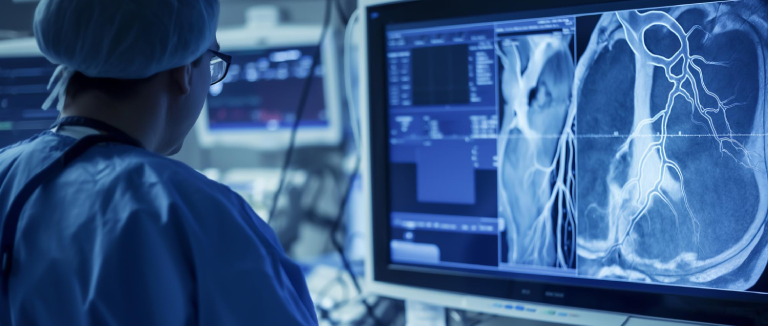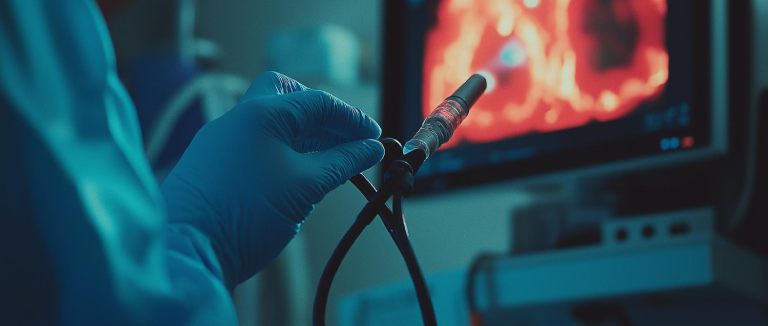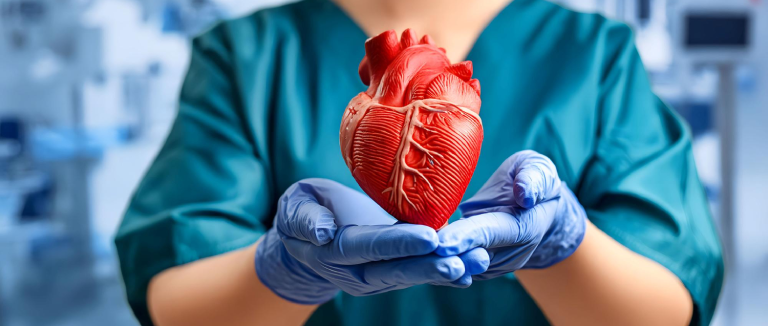Angiogram: Purpose, Procedure, and What It Shows
An angiogram is a diagnostic imaging procedure that uses X-rays and a special contrast dye to visualize blood vessels. It helps doctors detect blockages, narrowing, or other abnormalities in the blood vessels..

What Is an Angiogram?
An angiogram is a medical imaging procedure that allows doctors to visualize the inside of blood vessels, including arteries and veins, by injecting a special dye (contrast material) and using X-ray, CT (computed tomography), or MRI (magnetic resonance imaging) techniques. It is commonly performed to detect blockages, narrowing, aneurysms, or other abnormalities within the vessels that may increase the risk of serious health conditions such as heart attacks or strokes.
Definition and Purpose of Angiograms
Angiograms are a type of imaging test that uses X-rays and a special dye, known as a contrast agent, to make blood vessels visible. The contrast agent is injected into a vein or artery, and X-rays are taken of the area being studied. The resulting images help doctors diagnose a range of conditions, such as:
- Blockages in blood vessels
- Aneurysms (bulges in the wall of a blood vessel)
- Abnormal connections between arteries and veins
- Tumors that are fed by blood vessels
Angiograms can also guide minimally invasive treatments like angioplasty and stenting. These procedures use real-time imaging to help doctors open blocked blood vessels and restore proper blood flow.
How Angiograms Work: Imaging Technology Explained
Angiograms combine X-rays with a contrast agent to create detailed images of blood vessels. The contrast agent, injected into the bloodstream, absorbs X-rays and makes the blood vessels appear bright on the images. A special angiogram machine produces X-rays, which pass through the body and are captured by a detector. These signals are processed by a computer, resulting in clear, precise images that help doctors visualize and assess the blood vessels.
The Role of Angiograms in Modern Medicine
Angiograms play a crucial role in diagnosing and treating conditions that affect the circulatory system. Doctors commonly use angiograms to help identify:
- Heart disease
- Stroke
- Peripheral artery disease
- Kidney disease
- Cancer
Angiograms are also used to guide a variety of minimally invasive procedures, including:
- Angioplasty and stenting
- Embolization (blocking a blood vessel)
- Biopsy
Angiograms are generally safe and effective, but like any medical procedure, they do carry some risks, including:
- Allergic reaction to the contrast agent
- Bleeding
- Infection
Overall, angiograms are a vital diagnostic and treatment tool for a wide range of conditions. When performed by skilled medical professionals, the procedure is both safe and effective..
Why Are Angiograms Necessary?
Angiograms are essential because they provide detailed images of blood vessels, making them invaluable for diagnosing and treating a wide range of circulatory system conditions. These include heart disease, stroke, peripheral artery disease, and kidney problems. Additionally, angiograms help guide minimally invasive procedures like angioplasty and stenting, which can open blocked blood vessels and restore healthy blood flow.
Common Conditions Diagnosed with Angiograms
Angiograms are especially valuable for diagnosing and monitoring a variety of cardiovascular and vascular conditions, including:
- Coronary Artery Disease (CAD): The most common use for angiograms is to check for blockages or narrowing in the coronary arteries, which supply blood to the heart. This can help identify conditions like angina (chest pain) or heart attacks.
- The most common use of angiograms is to check for blockages or narrowing in the coronary arteries, which supply blood to the heart. This can help identify conditions like angina (chest pain) or heart attacks.
- Aneurysms: Angiograms can detect abnormal bulges in blood vessels, which may lead to life-threatening conditions like aortic aneurysm if left untreated.
- Stroke and Transient Ischemic Attacks (TIAs): A cerebral angiogram helps doctors identify blockages or narrowing in the brain's blood vessels, which can result in strokes or mini-strokes (TIAs).
- Peripheral Artery Disease (PAD): Angiograms assess blood flow in the legs, particularly when there is suspected narrowing or blockage in arteries that can cause pain or difficulty walking.
- Pulmonary Embolism: A pulmonary angiogram can detect blood clots in the lungs' blood vessels, a condition that could be fatal if untreated.
- Vascular Malformations: Angiograms are also used to find abnormal connections between arteries and veins, which can lead to bleeding or other complications.
- Angiograms are used to detect abnormal connections between arteries and veins, which could lead to bleeding or other complications.
When and Why Doctors Recommend Angiograms?
Doctors typically recommend angiograms when:
- Symptoms suggesting vascular problems: When a patient experiences severe chest pain, shortness of breath, leg pain while walking, or other symptoms that point to heart disease, stroke, or peripheral artery disease, an angiogram may be needed to accurately identify the cause.
- Unclear diagnosis from non-invasive tests: If tests like ultrasound or CT scans don't provide sufficient or clear information, an angiogram can offer more precise and detailed images.
- Pre-surgery planning: Angiograms are frequently performed before procedures such as stenting or bypass surgery to give the medical team a comprehensive view of the vascular system and help plan the intervention.
- Monitoring existing conditions: For patients with a known history of vascular diseases (for example, heart disease or stroke), angiograms may be scheduled at intervals to monitor disease progression or to assess how well current treatments are working.
Benefits of Angiograms in Early Detection and Treatment
- Early detection of problems
Angiograms provide highly detailed images, allowing doctors to spot blockages, narrowing, or aneurysms in their early stages. This can potentially prevent more serious issues like heart attacks or strokes. Because angiograms provide clear, detailed images, they help doctors identify issues before they become severe. - Precise diagnosis
With real-time, high-resolution imaging, angiograms enable accurate diagnosis. This leads to more specific and effective treatment plans, such as lifestyle changes, medication, stenting, or surgery. - Guiding treatment decisions
Angiogram results help doctors choose the best treatment option, including angioplasty, stent placement, or surgery. They also pinpoint exactly which blood vessels need intervention, minimizing risks from unnecessary procedures. Doctors can use angiogram results to determine the best course of action and identify which blood vessels need attention. - Prevention of serious complications
By identifying conditions such as coronary artery disease or vascular abnormalities early, angiograms help prevent serious outcomes like heart attacks, strokes, or severe bleeding. Prompt treatment based on these findings can greatly improve long-term health. - Minimally invasive and effective
Unlike more invasive procedures, angiograms are less risky and provide essential diagnostic information without the need for open surgery. This enables earlier intervention and sometimes helps patients avoid more complex surgical treatments.

Types of Angiograms
There are several types of angiograms, each designed to examine specific areas of the body. A coronary angiogram focuses on the arteries of the heart, while a cerebral angiogram examines the blood vessels in the brain. Peripheral angiograms assess blood vessels in the arms and legs, and pulmonary angiograms evaluate the vessels in the lungs. Renal angiograms are used to study kidney blood flow, and abdominal angiograms focus on the blood vessels in the abdomen. Each type is essential for diagnosing particular vascular conditions and guiding appropriate treatment.
Coronary Angiogram
A coronary angiogram allows doctors to visualize the coronary arteries, which supply blood to the heart. This test helps identify blockages or narrowing that can cause heart disease, angina, or heart attacks. During the procedure, a contrast dye is injected into the coronary arteries, and X-rays are used to capture detailed images of the blood vessels.
Cerebral Angiogram
A cerebral angiogram is a test that examines the blood vessels in the brain. It is mainly used to detect issues such as aneurysms, blood clots, or arterial malformations that may lead to strokes or other neurological problems. During this procedure, a contrast dye is injected into the arteries supplying the brain, allowing detailed imaging techniques to track blood flow and identify abnormalities.
Pulmonary Angiogram
A pulmonary angiogram examines the blood vessels in the lungs and is most often used to diagnose pulmonary embolism, a condition caused by blood clots that block the lung arteries. This test provides detailed images of the pulmonary arteries, allowing doctors to detect clots or other abnormalities in lung circulation.
Renal Angiogram
A renal angiogram is performed to assess the blood vessels in the kidneys. It helps detect problems such as renal artery stenosis (narrowing of the kidney arteries) or other vascular issues that can contribute to high blood pressure or kidney failure. This test is especially valuable for patients who have unexplained hypertension.
Peripheral Angiogram
A peripheral angiogram is used to assess the blood vessels in the arms and legs, primarily to diagnose peripheral artery disease (PAD). This test helps identify blockages or narrowing in the limb arteries, which, if left untreated, can cause pain, numbness, or other serious complications.
Digital Subtraction Angiography
Digital Subtraction Angiography (DSA) is an advanced imaging technique that produces clear, detailed images of blood vessels. The "subtraction" process involves digitally removing surrounding tissues from the images, so only the blood vessels remain visible. This precise method is especially useful for diagnosing complex vascular conditions where clarity is essential.
Preparing for an Angiogram
Preparing for an angiogram usually requires fasting for several hours beforehand, often starting at midnight if your procedure is in the morning. Certain medications, especially blood thinners, may need to be paused as directed by your doctor. Be sure to tell your healthcare provider about any allergies, particularly to contrast dye or iodine, and mention any existing health issues, such as kidney problems. You may need to have blood tests or other checks before the procedure. Finally, arrange for someone to drive you home, since you might feel drowsy from sedation after the angiogram.
Pre-procedure Tests and Consultations:
- Medical History and Physical Exam: Your doctor will review your medical history”including any conditions, allergies (especially to iodine or contrast dye), and all medications you take”and may also perform a physical exam.
- Blood Tests: These tests assess kidney function (which is important for processing the contrast dye) and evaluate blood clotting.
- Electrocardiogram (ECG/EKG): This simple test records your heart's electrical activity and is often performed before procedures involving the heart or major blood vessels.
- Consultations: You will likely consult with the interventional radiologist performing your angiogram and, if needed, other specialists. Use these meetings to ask questions and address any concerns you have.
Medications and Dietary Guidelines Before the Test
Medications: Your doctor will let you know if you need to stop any medications before your angiogram. This may include blood thinners (such as warfarin or clopidogrel), certain diabetes medicines (particularly metformin), or some diuretics. Always consult your doctor before making any changes to your medication.
Fasting: Most patients are asked to fast for 4“8 hours before the test. This usually means no food or drink, including water, after midnight or as instructed by your healthcare team. Fasting is important to minimize risks related to the contrast dye.
Hydration: Your doctor may recommend that you drink clear fluids up to a specific time before the procedure to help protect your kidneys, even though you are fasting from food.
- Fasting: You'll usually be asked to fast for a certain period before the procedure, typically 4-8 hours. This means no food or drink, including water, after midnight the night before or as instructed by your medical team. This is important to reduce the risk of complications related to the contrast dye.
- Hydration: While fasting from food, your doctor may advise you to drink clear fluids up to a certain point before the procedure to help protect your kidneys.
Day-of Procedure Checklist: What to Expect
- Arrival and Check-in: Check in at the hospital or clinic and sign the necessary consent forms.
- Changing into a Gown: Change into a hospital gown provided by the staff.
- IV Line Insertion: An IV line will be placed in your arm to deliver the contrast dye and any required medications.
- Monitoring: Your heart rate, blood pressure, and oxygen levels will be monitored throughout the procedure.
- Local Anesthesia: The insertion site (usually your groin or arm) will be cleaned and numbed with a local anesthetic.
- Catheter Insertion: A small incision is made, and a thin catheter is inserted into your artery.
- Contrast Dye Injection: The contrast dye is injected through the catheter; you may feel a warm or flushing sensation.
- X-ray Images: X-rays will be taken as the dye moves through your blood vessels.
- Catheter Removal and Closure: After imaging, the catheter is removed and pressure is applied to the site to prevent bleeding. A bandage will be placed.
- Recovery: You'll be observed for a few hours. You may need to lie flat for a while and could experience some bruising or soreness at the site.
- Discharge Instructions: You'll be given instructions on caring for the insertion site, activity restrictions, and follow-up appointments.
The Angiogram Procedure
An angiogram is a diagnostic test that uses X-rays and a special dye to visualize blood vessels throughout your body. It is often used to identify and treat conditions affecting the heart, brain, kidneys, and other organs. During the procedure, a thin, flexible tube (catheter) is inserted into an artery, typically in your groin or arm, and guided to the targeted area. Contrast dye is then injected through the catheter, making the blood vessels visible on X-ray images. As the dye flows, X-rays are taken to create detailed images that reveal any blockages, narrowing, or other abnormalities.
Step-by-Step Overview of the Process:
- Preparation: You will usually change into a hospital gown and lie on a procedure table. Local anesthesia is used to numb the insertion site (either your wrist or groin). Sedation may also be provided to help you relax, but many angiograms are performed with local anesthesia alone.
- The patient is typically asked to change into a hospital gown and lie down on a procedure table.
- Local anesthesia is administered to numb the area of insertion (wrist or groin).
- Sedation may also be offered to help the patient relax, though in many cases, the procedure can be done under local anesthesia alone.
- Insertion of Catheter:
- Wrist (Radial Access): A small incision is made in your wrist to insert a catheter into the radial artery. This approach is less invasive and allows for a quicker recovery compared to the groin route.
- Groin (Femoral Access): A small incision is made in your groin to insert the catheter into the femoral artery. This method is often chosen for complex procedures that require more space or specific equipment, but it carries a slightly higher risk of complications.
- Wrist (Radial Access): A small incision is made in your wrist to insert a catheter into the radial artery. This access point is less invasive and generally allows for a quicker recovery compared to the groin approach.
- Groin (Femoral Access): A small incision is made in your groin to insert the catheter into the femoral artery. This method provides more space for complex procedures or specialized equipment but carries a slightly higher risk of complications.
- Navigation to Target Area: The catheter is carefully navigated through your blood vessels to the specific area of interest. This step is usually monitored with fluoroscopy (live X-ray) to ensure accurate guidance and precise placement by the physician.
- The catheter is carefully guided through the blood vessels to the area of interest, typically using fluoroscopy (live X-ray) to visualize the catheter's path. The physician will monitor its progress to ensure precise placement.
- Procedure Execution: Once the catheter is in position”such as at a blockage in a coronary artery”the necessary procedure, like angioplasty, stent placement, or another intervention, is performed.
- Once the catheter reaches the target area”such as a blockage in a coronary artery”the necessary procedure, like angioplasty, stent placement, or another intervention, is carried out.
- Post-Procedure:
- After the procedure, the catheter is carefully removed and pressure is applied to the insertion site to stop any bleeding.
- The site may then be closed with a small bandage or sutures, if needed.
Different Access Points: Wrist vs. Groin
- Wrist (Radial Access):
- Pros: Reduced risk of bleeding, quicker recovery, less pain after the procedure, and greater patient comfort.
- Cons: Not ideal for some procedures”particularly in patients with small or hard-to-reach arteries.
- Groin (Femoral Access):
- Pros: Provides larger, more accessible arteries”making it the preferred choice for complex procedures or those needing greater maneuverability..
- Cons: Carries a higher risk of bleeding, hematoma (bruising), and infection, and generally requires a longer period of bed rest after the procedure.
Technology Used in the Procedure:
- Fluoroscopy: Offers real-time X-ray imaging, enabling doctors to track the catheter as it moves through your blood vessels.
- Catheters and Guidewires: Flexible, slender tubes that help doctors reach specific areas of your circulatory system to perform the procedure.
- Stents/Angioplasty Balloons: Used in angioplasty; a balloon is inflated to open narrowed blood vessels, and a stent may be inserted to keep the vessel open.
- Hemostasis Devices: Applied at the puncture site after the procedure to stop bleeding, such as pressure bands or specialized closure devices.
Duration and What Patients May Experience
- Duration
An angiogram usually takes between 30 minutes and 1 hour, depending on the complexity of the case and the method of access. - Patient Experience
- During the procedure
Patients are typically awake but sedated and experience little to no discomfort thanks to local anesthesia. - After the procedure
- Wrist access
Patients are encouraged to keep their wrist still for a short period and can often get up and move around within an hour or two. - Groin access
Patients are often asked to lie flat for several hours to reduce the risk of bleeding at the insertion site. - It is common to have mild soreness or bruising around the puncture site after the procedure.

After the Angiogram: Recovery and Results
After an angiogram, you'll typically stay in the hospital for a short observation period so the medical team can watch for bleeding or other issues at the insertion site. If the procedure was done via the wrist, you may be able to sit up and move within an hour or two, but should avoid strenuous activity for a day or so. If the groin was used, you'll need to lie flat for several hours to reduce bleeding risks. Mild soreness or bruising at the puncture site is common and generally resolves in a few days. Your doctor will usually discuss the results soon after the procedure to decide if any further treatment, like angioplasty or stenting, is needed. Most patients can return home the same day or the next, as long as they follow all recovery instructions.
Immediate Post-procedure Care
After the procedure, you'll be monitored, pressure will be applied to the puncture site to prevent bleeding, you'll need to rest and stay hydrated, and you might feel some mild discomfort.
- Monitoring: After the procedure, you'll be closely observed in a recovery room for several hours. Nurses will regularly check your vital signs (such as heart rate and blood pressure) and watch the puncture site for bleeding or swelling.
- Pressure: To help prevent bleeding, a nurse will apply pressure to the puncture site in your groin or arm, and may place a bandage or pressure dressing.
- Rest: If the procedure was through the groin, you'll need to lie still and keep your leg straight for a few hours to allow the site to heal properly.
- Hydration: You'll be encouraged to drink plenty of fluids to help remove the contrast dye from your body.
- Discomfort: Mild discomfort, bruising, or soreness around the puncture site is common. Tell your nurse if you're in pain”medication can be provided if needed.
What Do the Results Mean?
A normal angiogram means your blood vessels appear healthy. Abnormal results may show blockages, narrowing, aneurysms, or other problems, which your doctor will explain and discuss with you.
- Normal Results: A normal angiogram shows that your blood vessels are healthy, with no signs of blockages or narrowing.
- Abnormal Results: Abnormal results may show:
- Blockages: These could be caused by plaque buildup (atherosclerosis) or blood clots.
- Narrowing: This can restrict blood flow and may be caused by plaque or other conditions.
- Aneurysms: These are bulges in the blood vessel wall that are at risk of rupture.
- Other abnormalities: These could include malformations of the blood vessels.
- Discussion with your doctor: Your doctor will explain the results to you in detail and discuss any necessary treatment options. Don't hesitate to ask questions until you understand everything.
Follow-up Care and Lifestyle Adjustments
You can expect follow-up appointments, possible new medications, and advice on lifestyle changes”including diet, exercise, quitting smoking, and managing your weight.
- Follow-up appointments: You will likely have a follow-up appointment with your doctor to review the angiogram results and discuss any necessary treatment plans.
- Medications: Depending on the results of your angiogram, your doctor may prescribe medications such as blood thinners or cholesterol-lowering drugs..
- Lifestyle changes: Your doctor may recommend lifestyle changes to improve your heart health, such as:
- Healthy diet: Eating a diet low in saturated fat, cholesterol, and sodium.
- Regular exercise: Engaging in regular physical activity.
- Quitting smoking: If you smoke, quitting is essential.
- Weight management: Maintaining a healthy weight.
Common Recovery Questions Answered
Your nurse will let you know when it is safe to walk. Driving is generally not recommended for 24 hours after the procedure. When you can return to work depends on the type of job you have and how you feel. Some bruising at the puncture site is normal, but you should contact your doctor if you experience significant bleeding or swelling. Test results are typically available within a few days.
- When can I walk? Your nurse will advise you on when it's safe to get up and walk, which is typically a few hours after the procedure, depending on the access site and your recovery progress.
- When can I drive? You should generally avoid driving for 24 hours after the procedure, especially if the groin was used as the access site. Please discuss this with your doctor for personalized guidance.
- When can I return to work? Most people can return to work within a few days, depending on the nature of their job and how they're feeling after the procedure.
- What if I see bruising or bleeding? Mild bruising at the puncture site is normal. However, if you notice significant bleeding, swelling, or pain, contact your doctor immediately.
- When will I get the results? Results are usually available within a few days. Your doctor will schedule a follow-up appointment to review and explain your results.
Risks and Safety of Angiograms
Angiograms are generally considered safe procedures, but some risks do exist. The most common risks are allergic reactions to the contrast dye, bleeding or bruising at the insertion site, and damage to blood vessels. Serious complications, such as stroke or heart attack, are rare but possible. The likelihood of complications is higher for older adults or those with certain medical conditions, like diabetes or kidney disease. Before having an angiogram, it's important to talk with your doctor about the potential risks and benefits.
Potential Complications and How They are Managed
Possible complications from angiograms include:
Allergic reactions to the contrast dye, which can be managed with medication.
Bleeding or bruising at the insertion site, usually controlled with pressure or, if necessary, additional treatment.
Blood vessel damage, which typically heals on its own and rarely requires surgery.
Blood clots, which are usually prevented with medication.
Kidney damage, minimized by staying well-hydrated before and after the procedure.
Rare but serious events such as stroke or heart attack.
Pseudoaneurysm or arteriovenous (AV) fistula formation at the puncture site, which may require further procedures.
How Safe Are Angiograms? A Risk vs. Benefit Analysis
Angiograms are generally safe, but like any medical procedure, they do involve some risks. However, the benefits”such as providing an accurate diagnosis and helping guide treatment for serious conditions”typically outweigh these risks. For most patients, the likelihood of serious complications is low, particularly in those without significant underlying health issues. Doctors assess the risks and benefits for each individual before recommending an angiogram. In many cases, the information obtained from an angiogram can help prevent more serious health problems in the future.
Comparing Risks Across Different Types of Angiograms
While most angiograms carry similar overall risks, specific complications can vary depending on the procedure type. For example, cerebral angiograms have a slightly higher risk of stroke, while renal angiograms carry a greater risk of kidney damage. Your doctor will discuss the specific risks relevant to your case before your procedure.
- Coronary Angiogram (Heart): Has a small risk of heart attack, stroke, or arrhythmia.
- Cerebral Angiogram (Brain): Has a small risk of stroke.
- Peripheral Angiogram (Limbs): Has a small risk of blood vessel damage in the arms or legs. Renal Angiogram (Kidneys): Has a small risk of kidney damage.
* Liv Hospital Editorial Board has contributed to the publication of this content .
* Contents of this page is for informational purposes only. Please consult your doctor for diagnosis and treatment. The content of this page does not include information on medicinal health care at Liv Hospital .
For more information about our academic and training initiatives, visit Liv Hospital Academy
Frequently Asked Questions
What is an angiogram?
An angiogram is an imaging test that uses contrast dye and X-rays to show blood vessels and detect blockages or abnormalities.
How does an angiogram help diagnose health problems?
It reveals narrowing, blockages, aneurysms, and abnormal vessel structures that may cause heart attacks, strokes, or circulation issues.
Is an angiogram painful?
Most people feel only slight pressure because the procedure is done with local anesthesia, and discomfort is usually minimal.
How long does the angiogram procedure take?
The procedure typically lasts between 30 minutes and 1 hour, depending on the complexity.
What symptoms might lead a doctor to order an angiogram?
Chest pain, shortness of breath, leg pain while walking, dizziness, or unexplained vascular symptoms may prompt the test.
What types of angiograms are commonly performed?
Common types include coronary, cerebral, renal, pulmonary, and peripheral angiograms, depending on the area being examined.
What should patients avoid before an angiogram?
Patients are usually asked to fast for several hours and may need to pause certain medications like blood thinners.
How long is recovery after an angiogram?
Most people recover within a few hours, though groin-access procedures may require longer rest compared to wrist-access.
Are angiograms safe?
Yes. They are generally safe, with low risks of complications such as allergic reactions, bleeding, or vessel irritation.
When will I receive the angiogram results?
Most patients receive initial results the same day, with detailed explanations provided during follow-up with their doctor.




